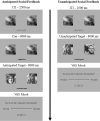Mind the social feedback: effects of tDCS applied to the left DLPFC on psychophysiological responses during the anticipation and reception of social evaluations
- PMID: 32412085
- PMCID: PMC8824563
- DOI: 10.1093/scan/nsaa066
Mind the social feedback: effects of tDCS applied to the left DLPFC on psychophysiological responses during the anticipation and reception of social evaluations
Abstract
The left dorsolateral prefrontal cortex (lDLPFC) is implicated in anticipatory (i.e. during anticipation of emotional stimuli) and online (i.e. during confrontation with emotional stimuli) emotion regulatory processes. However, research that investigates the causal role of the lDLPFC in these processes is lacking. In this study, 74 participants received active or sham transcranial direct current stimulation (tDCS) over the lDLPFC. Participants were told strangers evaluated them. These (rigged) social evaluations were presented, and in 50% of the trials, participants could anticipate the valence (positive or negative) of the upcoming social feedback. Pupil dilation (a marker of cognitive resource allocation) and skin conductance responses (a marker of arousal) were measured. The results indicate that active (compared to sham) tDCS reduced arousal during the confrontation with anticipated feedback but only marginally during the confrontation with unanticipated feedback. When participants were given the opportunity to anticipate the social feedback, tDCS reduced arousal, irrespective of whether one was anticipating or being confronted with the anticipated feedback. Moreover, tDCS reduced cognitive resource allocation during anticipation, which was associated with resource allocation increases during the subsequent confrontation. Altogether, results suggest that the lDLPFC is causally implicated in the interplay between anticipatory and online emotion regulatory processes.
Keywords: anticipation; dorsolateral prefrontal cortex; emotional processing; pupillary response; skin conductance response; transcranial direct current stimulation.
© The Author(s) 2020. Published by Oxford University Press. All rights reserved. For Permissions, please email: journals.permissions@oup.com.
Figures






Similar articles
-
Inverse effects of tDCS over the left versus right DLPC on emotional processing: A pupillometry study.PLoS One. 2019 Jun 19;14(6):e0218327. doi: 10.1371/journal.pone.0218327. eCollection 2019. PLoS One. 2019. PMID: 31216313 Free PMC article.
-
Transcranial direct current stimulation enhances cognitive control during emotion regulation.Brain Stimul. 2014 Jan-Feb;7(1):105-12. doi: 10.1016/j.brs.2013.08.006. Epub 2013 Sep 21. Brain Stimul. 2014. PMID: 24095257 Clinical Trial.
-
The effects of prefrontal tDCS and hf-tRNS on the processing of positive and negative emotions evoked by video clips in first- and third-person.Sci Rep. 2024 Apr 5;14(1):8064. doi: 10.1038/s41598-024-58702-7. Sci Rep. 2024. PMID: 38580697 Free PMC article.
-
Hemispheric dorsolateral prefrontal cortex lateralization in the regulation of empathy for pain.Neurosci Lett. 2015 May 6;594:12-6. doi: 10.1016/j.neulet.2015.03.042. Epub 2015 Mar 21. Neurosci Lett. 2015. PMID: 25805457 Clinical Trial.
-
The role of dorsolateral and ventromedial prefrontal cortex in the processing of emotional dimensions.Sci Rep. 2021 Jan 21;11(1):1971. doi: 10.1038/s41598-021-81454-7. Sci Rep. 2021. PMID: 33479323 Free PMC article.
Cited by
-
Prefrontal tDCS attenuates counterfactual thinking in female individuals prone to self-critical rumination.Sci Rep. 2021 Jun 2;11(1):11601. doi: 10.1038/s41598-021-90677-7. Sci Rep. 2021. PMID: 34078934 Free PMC article.
-
Anodal tDCS effects over the left dorsolateral prefrontal cortex (L-DLPFC) on the rating of facial expression: evidence for a gender-specific effect.Heliyon. 2021 Oct 27;7(11):e08267. doi: 10.1016/j.heliyon.2021.e08267. eCollection 2021 Nov. Heliyon. 2021. PMID: 34765784 Free PMC article.
-
Prefrontal tDCS Attenuates Self-Referential Attentional Deployment: A Mechanism Underlying Adaptive Emotional Reactivity to Social-Evaluative Threat.Front Hum Neurosci. 2021 Aug 17;15:700557. doi: 10.3389/fnhum.2021.700557. eCollection 2021. Front Hum Neurosci. 2021. PMID: 34483865 Free PMC article.
-
The Effects of Transcranial Direct Current Stimulation (tDCS) on the Cognitive Functions: A Systematic Review and Meta-analysis.Neuropsychol Rev. 2025 Mar;35(1):126-152. doi: 10.1007/s11065-023-09627-x. Epub 2023 Dec 7. Neuropsychol Rev. 2025. PMID: 38060075
-
Decision flexibilities in autism spectrum disorder: an fMRI study of moral dilemmas.Soc Cogn Affect Neurosci. 2022 Oct 3;17(10):904-911. doi: 10.1093/scan/nsac023. Soc Cogn Affect Neurosci. 2022. PMID: 35333369 Free PMC article.

